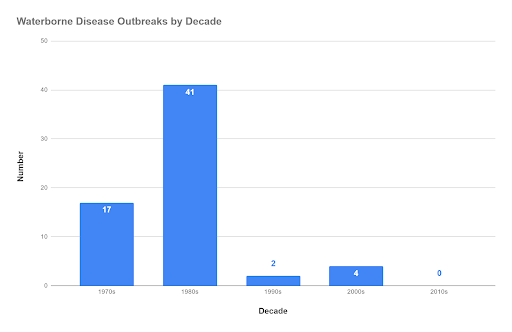In the Aqua Talk post on April 6 about the total coliform rule and potential for boil advisories, we discussed that we will publish additional articles about these large-scale boil advisories and the specific challenges and lessons learned. As a reminder, the four part series is covering the following topics:
- Total coliform perfect storm - incidents that could lead to a boil advisory - April 6, 2022
- Public notice to thousands - Special steps for large scale advisories - April 20, 2022
- What language do your customers communicate in? - Accomplishing public notification considering your community - May 11, 2022
- Do you really want to sample a home for compliance? - Total coliform special sample stations (today)
Both the Englewood boil advisory event in August, 2021 and the Marshall Fire that started on December 30, 2021 led to boil advisories affecting more than 25,000 people. To read more about the Marshall Fire boil advisories, see our April 13, 2022 article.
Today, we want to explore proper total coliform sampling locations. Generally, suppliers of water (regulatory speak for public water system operators and employees) collect total coliform samples from three types of sample taps:
- Indoor taps,
- Outdoor taps, spigots, or hose bibs, and
- Dedicated sample stations.
The regulations require that sample locations are previously identified in the supplier sample siting plan (sampling plan) and that the identified sampling sites and sample collection schedule are representative of water throughout the distribution system. Outside taps, spigots, and hose bibs are open to the atmosphere, dust, and animals. Such taps may be subject to higher levels of contamination than inside sampling taps or dedicated sample stations. Outside bacteria sampling sites are not generally recommended due to the risk of contamination, but are allowed.

Occasionally, suppliers may not have access to a previously identified sample location. If a supplier chooses to sample an outdoor sample location that is not identified in their sampling plan, the supplier must update its total coliform sample siting plan and make sure that the new site is representative of distribution system water quality. Suppliers can easily add their total coliform sample sites using the drinking water portal. If you have any questions, please contact your drinking water compliance specialist. Please be advised that the department will not invalidate positive total coliform or E. coli results just because the samples were collected at outdoor locations.
If a system chooses to collect total coliform samples from outside locations, the department recommends that the supplier take the necessary precautions to ensure that the sample tap is properly cleaned and disinfected with bleach or alcohol before the sample is collected.
Similarly, indoor sampling sites may be poor sampling sites. Any time water flows through internal building plumbing or pipes not under the control of the water system, the sample is susceptible to contamination. If a system chooses to collect total coliform samples from indoor locations, please be sure to always sample cold water, allow the water to flow for at least five minutes before sampling and remove any attachments on the faucet. The department recommends that the supplier take the necessary precautions to ensure that the sample tap is properly cleaned and disinfected with bleach or alcohol before the sample is collected. Avoid:
- thread taps, swing sprouts, leaky faucets, faucets connected to cisterns, softeners, pumps, pressure tanks
- hot water heaters and tempered water faucets that combine hot and cold water.
Please be advised that the department will not invalidate positive total coliform or E. coli results just because the samples were collected at indoor locations.
When considering where to take representative bacteriological sampling in your distribution system, it is important to consider that neither location discussed above, outdoor spigots or indoor private building taps best represent water in your distribution system. Despite the possibility that these sites may not be the most representative of water in the distribution system, they are allowed in the rule due to practicality of sampling throughout the service area.
An alternative to sampling at the locations indicated above is installing dedicated sampling stations. Regulation 11 and the Revised Total Coliform Rule allow for representative sampling from sample stations. Specifically, the rule states:
“monitoring locations may include a customer’s premises, dedicated sampling station, or other designated compliance sampling site.”
Sample stations could reduce the risk to suppliers of detecting site-specific contamination as mentioned above, due to issues with sample locations at outdoor spigots or indoor plumbing. Suppliers that install and sample from dedicated sample stations generally will have more control of the sampling tap by preventing its use by unauthorized persons and allowing no routine use of the tap except for sampling. A dedicated sample tap is also less susceptible to contamination and generally will be able to provide the most representative sample of a supplier's distribution system. The dedicated sample stations are installed on or near a water main therefore the quality of the water in the service mains is not impacted by service lines or a premise plumbing system. Sample stations could also allow suppliers more flexibility when identifying their system's most representative sample locations since they are not limited by owners or building occupants who may restrict access or not be available. Another benefit to these sample stations is that they can be used by the supplier to sample for other water quality parameters (i.e. chlorine residual, pH, turbidity).
Since several entities in Colorado already have experience with installing sampling stations and their proper upkeep, we recommend that utilities work with peers to properly budget, plan, and install sampling stations should you choose to pursue this specific option. The department is happy to provide contact information of utilities that have success with dedicated sampling stations.
➽ Jorge Delgado, P.E. CDPHE - WQCD








